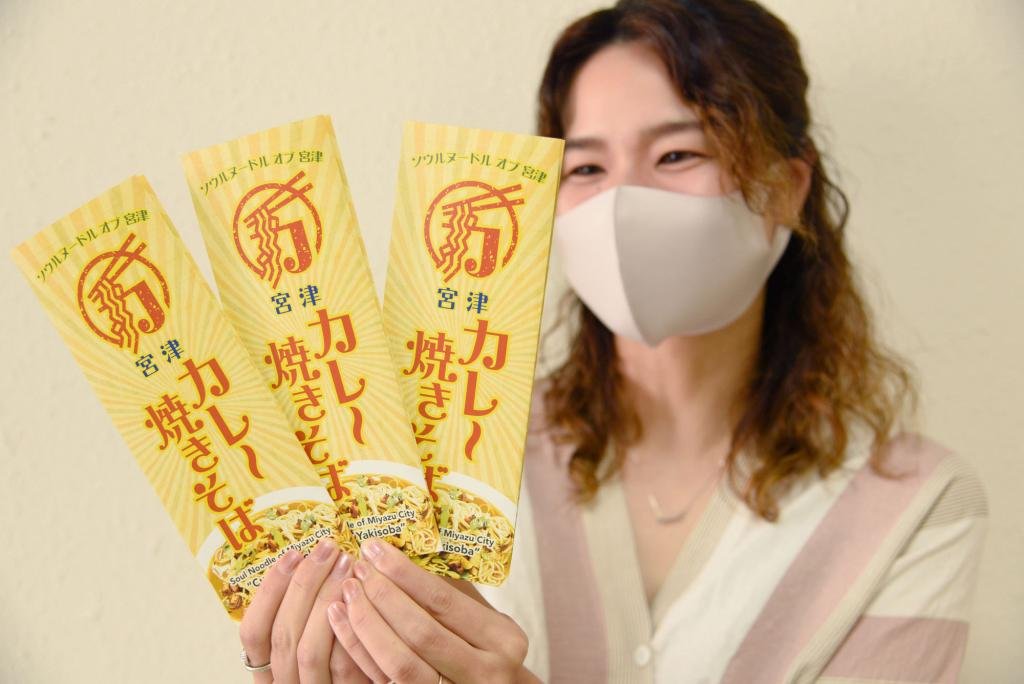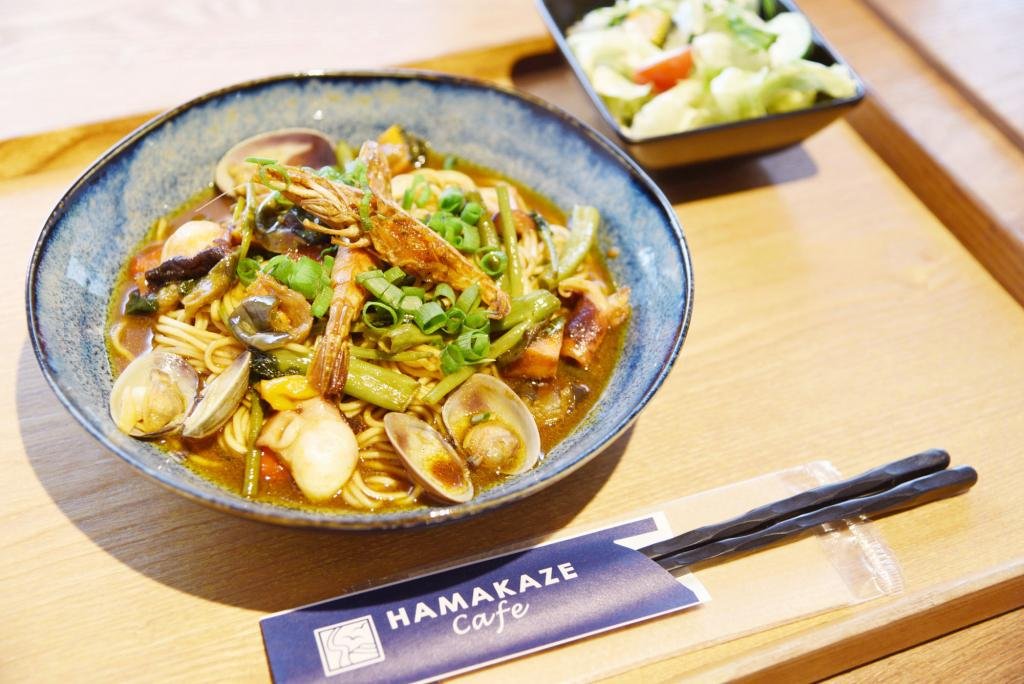Curry Yakisoba: soul food
town and culture 1.1.2022
Soba, udon, Chinese noodles, and pasta; this article is for noodle enthusiasts who love noodles from around the world. While most people visit Miyazu City in Kyoto to see Amanohashidate, one of Japan’s Three Scenic Views (in the city of Miyazu, Kyoto), gourmands are on the hunt for a “soul noodle” dish that was developed in the area. It’s called Miyazu Curry Yakisoba, a local delicacy that was brought to life during the post-war reconstruction period of Japan, a time when food cultures from different countries intertwined.
Miyazu Curry Yakisoba is said to have originated at Heiwaken, a Chinese restaurant in downtown Miyazu. The restaurant was opened by Mr. Wang, a cook who moved to Miyazu from Taiwan shortly after the war. He was in business from the 1950s until the beginning of the Heisei era.
Heiwaken was famous for its Chinese noodles, but it was also well-known for its curry yakisoba. It was based on Chinese cuisine, but had a twist. The unique soup stock was made with curry spices originating in India. It was a really popular dish that mixed the noodles with various ingredients.
The international flavor of the dish was unusual for the citizens at the time but quickly became a culinary success. Foe people who frequented Heiwaken during those days, it must have been an unforgettable flavor experience to be trying a single dish that mixed so many culutes’ cuisine.
And it caught on. More and more restaurants in Miyazu began to add curry yakisoba to their menus. The owners of Chinese restaurants, restaurants that specialized in set meals, izakaya (Japanese-style pubs), and other establishments began to offer their own versions.
|Re-debut 10-years ago
representatives of the restaurants that serve Miyazu yakisoba
In 2009, when the Miyazu Chamber of Commerce and Industry interviewed local restaurants to create a gourmet map, they noticed that many of them served curry yakisoba. Thinking that this would be a good way to revitalize the city, the Chamber of Commerce and Industry of Miyazu put a special section on the map and started selling it under the title “Miyazu Curry Yakisoba”.
In 2011, they planned a stamp booklet for people who visit twelve of the restaurants that serve curry yakisoba, and created a special map to market it as a local delicacy. There was a swell of interest both among visitors who were trying the dish for the first time, and also amongst locals who could trace the distinct flavors back decades.
Miyazu's curry yakisoba is a unique local delicacy in that it’s emergence was sudden and popularity unplanned. And because of this, there is no specific definition for how it should be prepared or what ingredients need to be used. Suffice to say that each restaurant has it’s own take and flavor; mild spices with cheese, a dry version with little to no broth, and more.
|Each Restaurant’s Own Signature Taste
Miyazu curry yakisoba maps
It is said that Heiwaken, the original restaurant, used a lot of soup stock, and there were restaurants that decided to emulate that style. But the promotional map includes a "dry and wet" chart that shows the amount of soup stock as well as some of the details of each restaurant.
In 2015, a major convenience store chain, interested in this delicacy, approached the group in Miyazu to develop a bread-based item for their stores. The bread was the unlikely collaboration between the convenience store chain and a general volunteer group of curry yakisoba fans. The resulting "Miyazu Curry Yakisoba Dog" was sold throughout convenience stores in the Kinki region while consequently raising awareness about Miyazu’s curry yakisoba.
The Miyazu Curry and Yakisoba Association, which was established during this collaboration, came out of the gates with a plan for ensuring more people heard about this unique local cuisine. They set up a dedicated website and restarted a stamp booklet promotion. A "gold card" was also issued to those who completed the booklet, offering special benefits at each restaurant. With increased exposure in the media, people began to recognize the Miyazu Curry Yakizoba name.
|A deep culinary following
Norio Itoi, who has been running "Restaurant Itonaka" for three generations in Tsuruga, Miyazu City, says, “We have seen an increase in the number of tourists and other first-time customers.” Itonaka is a set meal restaurant that is frequented by businessmen during the day and the general public at night. They started serving curry yakisoba around 1990.
According to Mr. Itoi, it all started about 30 years ago with one his regulars. One of his regular customers asked for curry powder to be sprinkled over the yakisoba sauce (yakisoba being a regular dish at the time), and so Mr. Itoi abided. And some time after, "curry-flavored yakisoba" became a household name at the restaurant.
It is a simple dish of pork and vegetables like cabbage, onions, and carrots, stir-fried with curry powder and seasoned with sauce. It is slightly spicy and goes well with beer. Mr. Itoi says, "People who come to the restaurant after having not eaten here for a long time often say, ‘I’ve missed this. I’m glad that the taste hasn't changed at all.’ We even have customers who only order curry yakisoba.”
|It’s still evolving
On the other side of the curry yakisoba legacy is HAMAKAZE Cafe, a roadside station restaurant in Hamacho (Miyazu City), that offers an "evolutionary" type of curry yakisoba. It is filled with seafood such as shrimp, clams, and squid, and looks like a Western dish. It’s also a spicy yakisoba and uses soy sauce in the base. Before COVID, they were making 2,000 servings a year.
The roadside station turned this popular dish into a souvenir you could bring home, commercializing the dish with instant noodles in order to introduce Miyazu's “soul noodles” to the rest of the world. The noodles are easy to prepare, taste delicious, and come in a cute package that has become a popular image on social networking sites. This past summer alone, about 6,600 bags were sold.
During the declared state of emergency, many restaurants were closed, and Miyazu was no exception. On social media, people who have had the instant noodles comment things like, "I can’t wait to visit Miyazu for some curry yakisoba!”
|The instant noodles connecting restaurants and customers
The instant noodles have created a more widespread group of devotees, and have also created a connection to the restaurants that were forced to close temporarily during the COVID pandemic. Mr. Masashi Hosomi, manager of the roadside station where the instant noodles are sold, said, "I am surprised, but also very happy to see such interest.”
Mr. Itoi of Itonaka, who continues to operate his business, said, "I just hope that things will return to normal soon. I hope that many more people will visit us again when the COVID situation has subsided. Our recipe will still be unchanged when people can come back!”
Try them at home. Kyoto by the Sea Marketplace (Rakuten Shopping linked on picture) is selling curry yakisoba instant noodles in four-pack boxes.
The following are members of the Miyazu Curry and Yakisoba Society listed on the curry yakisoba website (https://curryyakisoba.com/) and map. Some restaurants may close in the event of another COVID outbreak, so please check in advance: Sake cellar Tamura (Shinhama) ・HAMAKAZE Cafe (Hamacho), Cafe Rest Erina (Bannen), Restaurant Itonaka (Tsuruga), Hashidate Daimaru Main Store (Bunju), Zuishoen (Kokubu), Chinese Cuisine Pork Chin Kan (Shinhama), Restaurant Ryoren (Fisherman), Restaurant Shogin (Bunju) Shogin (Bunju).
There are also some restaurants in Miyazu that serve curry-flavored yakisoba noodles, even if though they are not members of this group. Time to search out Miyazu’s soul noodles!









